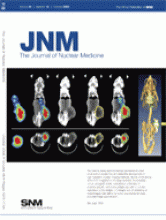REPLY: We greatly appreciate the thoughtful comments of Troost et al. on the potential influence of timing and duration of carbogen breathing on tracer uptake in our study (1).
In their letter, Troost et al. stressed that the effect of carbogen breathing on hypoxia decreased after 60 min of breathing time and that prolonged carbogen breathing returned hypoxia to baseline measurements. In the cited article, tissue oxygenation measurements were performed on 2 mice bearing human tumor xenografts using a fiberoptic probe with a luminescence-based optical O2 sensor (2). Typically, such probes are advanced into the tumor tissue and measurements are taken at the tip of the probe. Although direct oxygen probes are regarded as the gold-standard measurement of tissue oxygenation, they are limited because of their invasiveness and technical challenges. Even if great care is taken to maintain the position of the head of the probe, movements are difficult to monitor and usually cannot be excluded, potentially influencing measurement results. Longitudinal oxygen-probe measurements have also been criticized because the continued presence of the head of the probe in tissue may decrease or disrupt tissue perfusion because of local tissue injury, causing edema and microhematomata that might interfere with longitudinal measurements (even if the oxygen sensor system itself does not consume oxygen during measurements). Also, animals breathing carbogen for more than 3 h must have been anesthetized, and the observed effects on tumor oxygenation may have been in part related to an overall effect of prolonged anesthesia. In addition, because of the heterogeneity of tumor tissue, oxygenation readings may not have been representative of the tumor as a whole. Therefore, some researchers favor motorized probes that allow the investigation of a certain fraction of the tumor by advancing and retracting the tip of the probe in defined ways. Using such an oxygen sensor system, we were able to show that the uptake of 18F-misonidazole (FMISO) is inversely correlated with tissue oxygenation in a dedicated hypoxia model in porcine liver (3,4). Even if prolonged carbogen breathing resulted in a return of hypoxia in the tumors investigated by Kaanders et al., such a behavior does not necessarily have to occur in the EMT6 tumor xenografts used in our study. We have now repeatedly shown that prolonged (4 h) carbogen breathing generally decreases tumor tissue hypoxia as measured by 18F-azomycin arabinoside (FAZA) in EMT6 tumors using biodistribution studies, autoradiography, and small-animal PET (1,5).
Troost et al. argued that the signal intensity of pimonidazole decreased significantly after carbogen breathing (in 2 of 3 tumor lines) and that the 18F-FMISO signal intensity decreased slightly, although not significantly (6). Because pimonidazole is generally regarded as a suitable immunohistochemical marker of tissue hypoxia, a strong and stable correlation of pimonidazole staining and 18F-FMISO uptake would be expected if the retention of 18F-FMISO in tissue is in fact (mostly) oxygenation-dependent. We would like to point out that the in vivo kinetics of 18F-FMISO and 18F-FAZA are quite different. Compared with 18F-FAZA, 18F-FMISO displays a significantly slower clearance from normal (normoxic) tissues (5). Imaging at relatively early time points (1 h after tracer injection) may therefore not be sufficient to detect an oxygenation-specific signal from 18F-FMISO and could have contributed to a more variable spatial correlation between pimonidazole and 18F-FMISO in their study (6).
Troost et al. further reasoned that the CO2 component of the carbogen can lead to a decreased tumor perfusion mediated by a steal effect of vessels surrounding the tumor tissue (7) and that this effect may have caused the discrepancy found between the results for 18F-FAZA and for hypoxia-inducible factor-1α. Our results indicated that after 4 h of carbogen breathing, the HIF-1α expression was not influenced whereas the hypoxic tumor surface as depicted by 18F-FAZA was significantly decreased, compared with ambient (control) conditions. We dispute that this effect would explain our results. 18F-FAZA was coinjected with 125I-gluco-RGD peptide. Although the mean 18F-FAZA uptake decreased, the mean 125I-gluco-RGD uptake was unaffected; therefore, any reduction in tumor perfusion (steal effect) would have caused a reduction in tracer delivery and, thus, a reduction of uptake for both tracers. However, our data indicated that the overall 125I-gluco-RGD uptake was not modified by carbogen, making a steal phenomenon highly unlikely.
We agree that our results are specific to the tumor model used. However, we were limited to infrequent tumor cell lines that regularly result in tumor hypoxia and at the same time lack any αvβ3 expression on the tumor cell surface (8), allowing us to use 125I-gluco-RGD uptake on activated endothelial cells as a measure of αvβ3-mediated angiogenesis. Although our tumor model resulted in an unpredictable (random) pattern of hypoxia and angiogenesis within the tumor core, other tumor cell lines may produce different patterns of hypoxia, which—by the way—will also likely undergo changes over time, especially when treatment is applied. Because of the extensive tissue heterogeneity observed in many malignancies, molecular imaging of the tumor microvasculature of individual cancers is crucial. We should not be discouraged by technical difficulties but continue to translate these observations into the clinic by evaluating tumor perfusion, angiogenesis, and tissue oxygenation to improve our understanding of treatment response to chemotherapy and radiation on an individual basis.
Footnotes
-
COPYRIGHT © 2008 by the Society of Nuclear Medicine, Inc.







